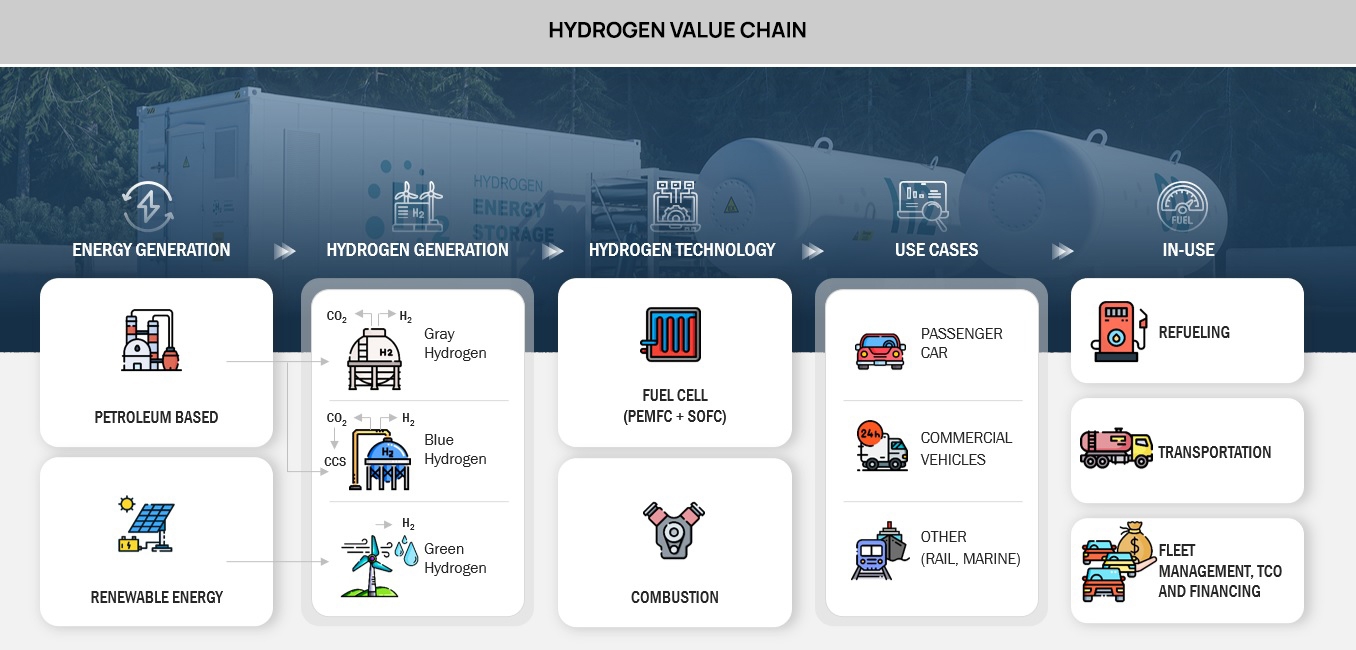Emerging Techno-Commercially attractive Hydrogen Business Models - Hydrogen Generation, Hydrogen Storage, and Hydrogen Distribution.
Hydrogen Generation:
· Steam Methane Reforming (SMR):
Steam Methane Reforming (SMR): SMR is currently the most common method for large-scale hydrogen production, accounting for the majority of global hydrogen supply. It involves reacting natural gas (methane) with steam to produce hydrogen and carbon dioxide. SMR is a mature technology and has well-established infrastructure. However, it is associated with greenhouse gas emissions unless carbon capture and storage (CCS) technologies are employed.
1. Natural Gas Reforming: Methane is the primary component of natural gas, and it serves as the source of hydrogen in SMR. Methane molecules are broken down into hydrogen and carbon in a process known as reforming. This step is endothermic, meaning it requires energy input.
2. Water-Gas Shift Reaction: After reforming, the produced hydrogen gas is further purified and adjusted for the desired hydrogen-to-carbon monoxide (H2/CO) ratio. This step may involve the water-gas shift reaction, where water vapor reacts with carbon monoxide to produce additional hydrogen and carbon dioxide.
3. Hydrogen Purification: Hydrogen gas is separated and purified to remove impurities, such as carbon dioxide and carbon monoxide, which are unwanted byproducts.
The carbon dioxide produced in the process is released into the atmosphere, contributing to greenhouse gas emissions. Methane, which is a potent greenhouse gas itself, is also released during natural gas production and transportation.
To address the greenhouse gas emissions associated with SMR, carbon capture and storage (CCS) technologies can be employed. CCS involves capturing the carbon dioxide generated during hydrogen production and storing it underground or repurposing it for various industrial applications.
while SMR is a mature and well-established technology for hydrogen production, it produces carbon dioxide emissions, which contribute to global warming. To make SMR more environmentally sustainable, CCS technologies are used to capture and store the carbon dioxide emissions, reducing the environmental impact of hydrogen production. In the long term, efforts are also being made to develop more sustainable hydrogen production methods, such as green hydrogen production through electrolysis using renewable energy sources, to further reduce greenhouse gas emissions associated with hydrogen production.
DOWNLOAD- https://www.marketsandmarkets.com/industry-practice/RequestForm.asp
· Top of Form
· Electrolysis:
Electrolysis is a promising method for hydrogen generation, particularly when powered by renewable energy sources. It involves using electricity to split water into hydrogen and oxygen. There are different types of electrolyzers, including alkaline, polymer electrolyte membrane (PEM), and solid oxide electrolysis cells (SOEC). Electrolysis offers the advantage of producing hydrogen without carbon emissions, making it suitable for clean hydrogen production. The costs of electrolyzers are gradually decreasing, making electrolysis more commercially attractive.
There are several types of electrolyzers, each with its own characteristics and applications:
Alkaline Electrolysis (AE): Alkaline electrolyzers use an alkaline solution (usually potassium hydroxide) as the electrolyte. They have been used for several decades and are known for their reliability and efficiency.
Polymer Electrolyte Membrane (PEM) Electrolysis: PEM electrolyzers use a solid polymer membrane as the electrolyte, which conducts protons (H+ ions) but not electrons. They are compact, have fast response times, and can operate at relatively low temperatures (around 80°C).
Solid Oxide Electrolysis Cells (SOEC): SOECs operate at high temperatures (typically between 600-900°C) and are capable of achieving high efficiencies. They can be reversible, meaning they can switch between electrolysis mode (producing hydrogen) and fuel cell mode (converting hydrogen back into electricity).
The advantages of electrolysis for hydrogen generation include:
Zero Carbon Emissions: Electrolysis, especially when powered by renewable energy sources like solar or wind, produces hydrogen without any greenhouse gas emissions.
Flexibility and Grid Balancing: Electrolyzers can be used to store excess electricity from renewable sources when demand is low and then generate hydrogen when demand is high.
Decentralized Production: Electrolyzers can be deployed at various scales, from small residential systems to large industrial installations. This allows for decentralized hydrogen production, reducing the need for long-distance transportation.
Compatibility with Existing Infrastructure: Hydrogen produced via electrolysis can be integrated into existing hydrogen infrastructure, making it easier to adopt and distribute for various applications.
READ MORE- https://www.marketsandmarkets.com/industry-practice/hydrogen/emerging-hydrogen-business-models


